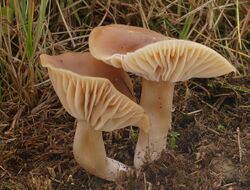Biology:Cuphophyllus colemannianus
| toasted waxcap | |
|---|---|

| |
| Scientific classification | |
| Domain: | Eukaryota |
| Kingdom: | Fungi |
| Division: | Basidiomycota |
| Class: | Agaricomycetes |
| Order: | Agaricales |
| Family: | Hygrophoraceae |
| Genus: | Cuphophyllus |
| Species: | C. colemannianus
|
| Binomial name | |
| Cuphophyllus colemannianus (A. Bloxam) Bon (1985)
| |
| Synonyms | |
| |
Cuphophyllus colemannianus is a species of agaric (gilled mushroom) in the family Hygrophoraceae. It has been given the recommended English name of toasted waxcap.[2] The species has a European distribution, occurring mainly in agriculturally unimproved grassland. Threats to its habitat have resulted in the species being assessed as globally "vulnerable" on the IUCN Red List of Threatened Species.[1]
Taxonomy
The species was first described from Britain in 1854 by naturalist Andrew Bloxam as Hygrophorus colemannianus. It was transferred to the genus Cuphophyllus by the French mycologist Marcel Bon in 1985.
Recent molecular research, based on cladistic analysis of DNA sequences, has confirmed that Cuphophyllus colemannianus is a distinct species.[3]
Description
Basidiocarps are agaricoid, up to 50mm (5 in) tall, the cap hemispherical at first, becoming broadly convex to flat when expanded, up to 50mm (3 in) across. The cap surface is smooth, slightly greasy when damp, brown with paler margin. The lamellae (gills) are waxy, thick, decurrent (running down the stipe), white to pale buff. The stipe (stem) is smooth, white, lacking a ring. The spore print is white, the spores (under a microscope) smooth, inamyloid, ellipsoid, c. 7.5 to 9 by 5 to 6μm.[4]
Distribution and habitat
The Toasted Waxcap is widespread but generally rare throughout Europe. It is also known from Greenland.[1] Like most other European waxcaps, Cuphophyllus colemannianus occurs in old, agriculturally unimproved, short-sward grassland (pastures and lawns), with a marked preference for calcareous sites.[4]
Recent research suggests waxcaps are neither mycorrhizal nor saprotrophic but may be associated with mosses.[5]
Conservation
Cuphophyllus colemannianus is typical of waxcap grasslands, a declining habitat due to changing agricultural practices. As a result, the species is of global conservation concern and is listed as "vulnerable" on the IUCN Red List of Threatened Species.[1] Cuphophyllus colemannianus also appears on the official or provisional national red lists of threatened fungi in several European countries, including Croatia,[6] Czech Republic,[6] Denmark,[7] Finland,[6] Germany,[8] Norway,[6] and Sweden.[6]
See also
References
- ↑ 1.0 1.1 1.2 1.3 Mešić, A. "Cuphophyllus colemannianus. The IUCN Red List of Threatened Species". https://www.iucnredlist.org/species/147321083/147967039. Retrieved 2022-05-02.
- ↑ Holden L. (April 2022). "English names for fungi 2022". British Mycological Society. https://www.britmycolsoc.org.uk/resources/english-names/. Retrieved 2022-05-02.
- ↑ Lodge DJ (2014). "Molecular phylogeny, morphology, pigment chemistry and ecology in Hygrophoraceae (Agaricales)". Fungal Diversity 64 (1): 1–99. doi:10.1007/s13225-013-0259-0. https://iris.unito.it/bitstream/2318/136089/1/1205754_Molecular%20phylogeny.pdf.

- ↑ 4.0 4.1 Boertmann D. (2010). The genus Hygrocybe (2nd ed.). Copenhagen: Danish Mycological Society. pp. 200. ISBN 978-87-983581-7-6.
- ↑ "Conservation of biotrophy in Hygrophoraceae inferred from combined stable isotope and phylogenetic analyses". Mycologia 103 (2): 280–290. 2011. doi:10.3852/10-195. PMID 21139028.
- ↑ 6.0 6.1 6.2 6.3 6.4 "National red Lists". https://www.nationalredlist.org/search2/species-search/.
- ↑ "Den danske rødliste: Cuphophyllus colemannianus". https://ecos.au.dk/forskningraadgivning/temasider/redlistframe/soeg-en-art#10171.
- ↑ "Red List: Cuphophyllus colemannianus". Rote Liste Zentrum. https://www.rote-liste-zentrum.de/en/Detailseite.html?species_uuid=34681269-5ead-402c-ae52-f3c9ee2df2af&species_organismGroup=Gro%C3%9Fpilze&q=cuphophyllus%20colemannianus.
Wikidata ☰ Q1172710 entry
 |


